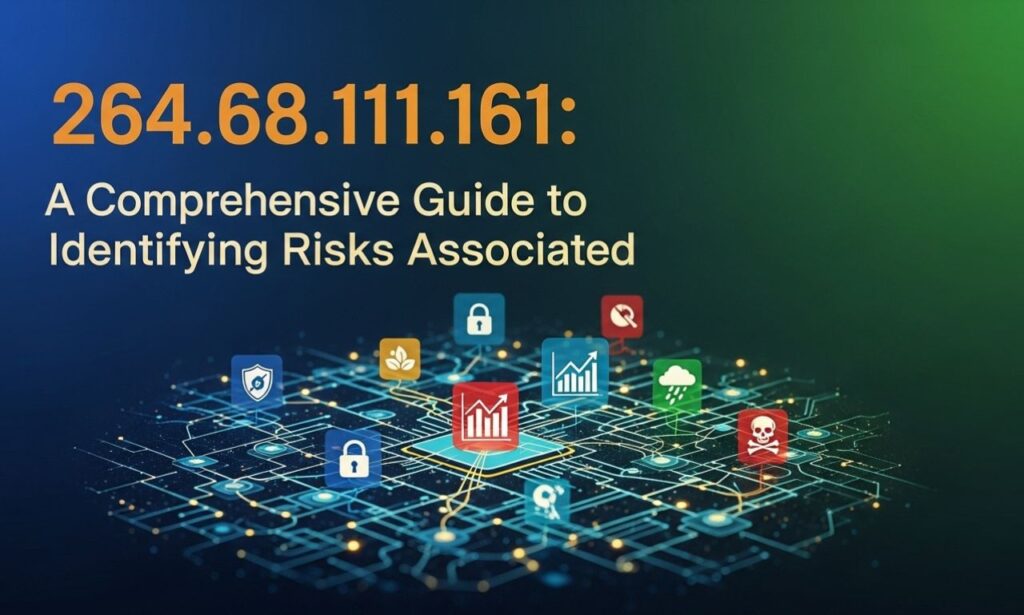In today’s digital landscape, understanding cybersecurity is more crucial than ever. With countless IP addresses connecting devices across the globe, each one can hold potential risks or vulnerabilities. One such address that has raised eyebrows in recent discussions is 264.68.111.161. But what does this mean for you? Whether you’re a casual internet user or a seasoned tech enthusiast, knowing how to navigate the complexities of IP addresses and their associated risks is vital for your online safety.
This guide will delve into what makes 264.68.111.161 noteworthy and explore its implications for risk management in cybersecurity practices. By equipping yourself with knowledge about this particular IP address, you can take proactive steps toward safeguarding your online presence against threats lurking in the shadows of cyberspace.
What is 264.68.111.161?
264.68.111.161 is an Internet Protocol (IP) address, a unique identifier assigned to devices connected to the internet or a local network. Each IP address facilitates communication between these devices by allowing them to send and receive data.
This specific IP falls within the range typically used for private networks but can also be seen in various public-facing scenarios. Understanding its function is crucial for anyone involved in cybersecurity or network management.
When you encounter this IP, it’s essential to analyze its behavior and context of use carefully. It may belong to a legitimate service provider or could potentially be associated with suspicious activities.
Monitoring such addresses helps identify potential threats that may compromise your digital security.
How can this IP address pose a risk?
The IP address 264.68.111.161 can pose various risks, primarily due to its association with potential malicious activities online. It may serve as a gateway for cybercriminals looking to exploit vulnerabilities in your network.
Given that each IP address is unique, if this one is linked to suspicious behavior or malware, it could compromise personal and sensitive information stored on devices connected to the internet.
Moreover, attackers often use such addresses to launch Distributed Denial of Service (DDoS) attacks. This type of assault floods a target’s server with traffic, causing disruptions that could lead to significant downtime and financial losses.
Phishing attempts are another concern tied to specific IP addresses like 264.68.111.161. Cybercriminals frequently rely on these tactics, tricking users into revealing credentials through fake websites or emails mimicking legitimate sources.
Staying aware of these risks associated with particular IP addresses can greatly enhance your cybersecurity posture and protect your digital assets from harm.
Identifying the Source of the Risk
To effectively manage risks associated with the IP address 264.68.111.161, identifying its source is crucial. Start by performing a reverse lookup to determine the host name and organization behind it.
Utilizing network monitoring tools can provide insights into traffic patterns linked to this IP. Such tools help in pinpointing unusual activities that might indicate malicious intent.
Investigate whether the address has been reported for suspicious behavior on cybersecurity forums or databases. Many websites track flagged IPs and may already have valuable information regarding potential threats.
Additionally, cross-reference data from reputable sources like threat intelligence platforms to enrich your understanding of any associated risks. By piecing together these details, you can form a clearer picture of what you’re dealing with related to 264.68.111.161, enabling better preventive measures against potential harm.
Steps to Protect Yourself from Potential Threats
To shield yourself from potential threats associated with 264.68.111.161, start by regularly updating your software and operating systems. Patches often fix security vulnerabilities that can be exploited.
Implement a robust firewall to monitor incoming and outgoing traffic. This acts as a barrier between your network and harmful entities lurking online.
Utilize virtual private networks (VPNs) when accessing public Wi-Fi. This encrypts your data, making it nearly impossible for attackers to intercept sensitive information.
Be wary of unsolicited emails or messages asking for personal details. Phishing attempts often masquerade as legitimate communications but seek to compromise your security.
Regularly back up important data on an external drive or cloud service. In the event of a cyber attack, you’ll have access to vital information without succumbing to ransom demands.
Engage in continuous education about cybersecurity trends and best practices; knowledge is one of the most effective tools against threats in today’s digital landscape.
Resources for Further Protection and Education
When it comes to cybersecurity, staying informed is key. Numerous online resources can enhance your understanding and help you protect against threats like those associated with 264.68.111.161.
Websites such as Cybersecurity & Infrastructure Security Agency (CISA) offer valuable insights into current risks and best practices for security. They cover everything from recognizing phishing attempts to securing your home network.
Additionally, platforms like Coursera provide courses on cybersecurity fundamentals. These courses are designed for all skill levels, making them accessible whether you’re a beginner or more experienced.
Don’t overlook forums and community groups dedicated to cybersecurity discussions. Engaging with others can lead to shared knowledge and practical tips tailored to current challenges in the digital world.
Podcasts focused on tech security also serve as excellent learning tools while you’re on the go, providing expert opinions and real-world cases that illuminate potential risks effectively.
Conclusion
Understanding IP addresses like 264.68.111.161 is essential in today’s digital landscape. Cybersecurity threats are real and can come from many sources, including seemingly innocuous IP addresses.
By identifying the potential risks associated with this specific address, you can better protect yourself online. It’s vital to remain vigilant and adopt proactive measures to safeguard your personal information.
Educating yourself on cybersecurity practices will empower you to navigate the internet safely while minimizing vulnerabilities.
Staying informed about emerging threats will help ensure that you’re prepared for any challenges that may arise in the future regarding online safety and security.






